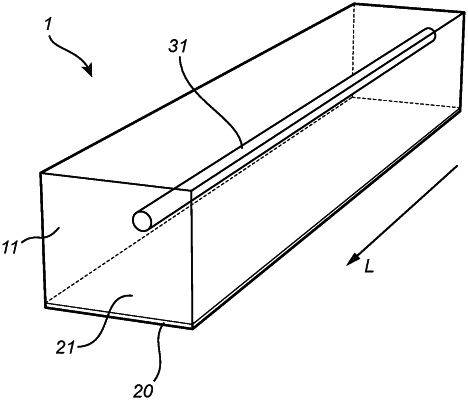| CPC F21V 7/0083 (2013.01) [F21S 8/026 (2013.01); F21V 14/006 (2013.01); F21Y 2115/10 (2016.08)] | 13 Claims |

|
1. A linear lighting device having a length, a width, and a longitudinal axis, an aspect ratio of the length and width being at least 2, the linear lighting device comprising:
a cavity, extending along the longitudinal axis, the cavity being defined by an interior surface configured to reflect light impinging upon the interior surface of the cavity, the cavity having an opening permitting light inside the cavity to exit the cavity;
an optical module, arranged in or at the opening of the cavity, and configured to transmit light impinging upon a surface of the optical module through the optical module, wherein light transmitted through the optical module is emitted from the lighting device;
a plurality of light emitting elements arranged in a succession along the longitudinal axis of the lighting device and arranged in the cavity, and configured to emit first light, impinging on the surface of the optical module without having first impinged on the interior surface of the cavity, and second light, impinging on the interior surface of the cavity; and
wherein the optical module comprises a linear collimator configured to collimate the first light in a transverse plane, the transverse plane being perpendicular to the longitudinal axis of the lighting device, and produce collimated light so as to increase the degree of collimation of light, in the transverse plane, transmitted from the optical module as compared to the first light prior to transmission through the optical module,
wherein at least one of the plurality of light emitting elements is arranged such that the first light emitted by the plurality of light emitting elements is light for which less than 3% of the total luminous flux is in the wavelength range between 400-470 nm, and
wherein at least one of the interior surface of the cavity, the plurality of light-emitting elements and the optical module is or are configured such that the second light, reflected by the interior surface of the cavity and subsequently having impinged upon the surface of the optical module and transmitted from the optical module, is light for which at least 3% of the total luminous flux is in the wavelength range 400-470 nm.
|